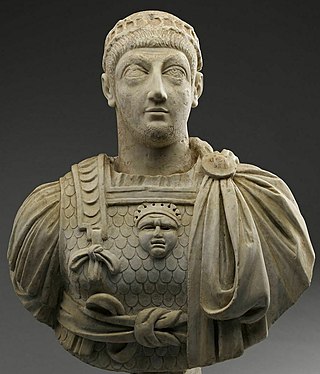
Huneric,Hunneric or Honeric was King of the Vandal Kingdom (477–484) and the oldest son of Gaiseric. He abandoned the imperial politics of his father and concentrated mainly on internal affairs. He was married to Eudocia, daughter of western Roman Emperor Valentinian III (419–455) and Licinia Eudoxia. The couple had one child, a son named Hilderic.
The 380s decade ran from January 1, 380, to December 31, 389.
The 430s decade ran from January 1, 430, to December 31, 439.
The 420s decade ran from January 1, 420, to December 31, 429.
The 450s decade ran from January 1, 450, to December 31, 459.

Year 451 (CDLI) was a common year starting on Monday of the Julian calendar. At the time, it was known as the Year of the Consulship of Marcianus and Adelfius. The denomination 451 for this year has been used since the early medieval period, when the Anno Domini calendar era became the prevalent method in Europe for naming years.
The 390s decade ran from January 1, 390 to December 31, 399
The 440s decade ran from January 1, 440, to December 31, 449.
The 460s decade ran from January 1, 460, to December 31, 469.

Year 455 (CDLV) was a common year starting on Saturday of the Julian calendar. At the time, it was known as the Year of the Consulship of Valentinianus and Anthemius. The denomination 455 for this year has been used since the early medieval period, when the Anno Domini calendar era became the prevalent method in Europe for naming years.

Year 460 (CDLX) was a leap year starting on Friday of the Julian calendar. At the time, it was known as the Year of the Consulship of Magnus and Apollonius. The denomination 460 for this year has been used since the early medieval period, when the Anno Domini calendar era became the prevalent method in Europe for naming years.
Year 444 (CDXLIV) was a leap year starting on Saturday of the Julian calendar. At the time, it was known as the Year of the Consulship of Theodosius and Aginatius. The denomination 444 for this year has been used since the early medieval period, when the Anno Domini calendar era became the prevalent method in Europe for naming years.
Year 442 (CDXLII) was a common year starting on Thursday of the Julian calendar. At the time, it was known as the Year of the Consulship of Dioscorus and Eudoxius. The denomination 442 for this year has been used since the early medieval period, when the Anno Domini calendar era became the prevalent method in Europe for naming years.

Valentinian III was Roman emperor in the West from 425 to 455. Starting in childhood, his reign over the Roman Empire was one of the longest, but was dominated by civil wars among powerful generals and the invasions of late antiquity's Migration Period.

The Theodosian dynasty was a Roman imperial family that produced five Roman emperors during Late Antiquity, reigning over the Roman Empire from 379 to 457. The dynasty's patriarch was Theodosius the Elder, whose son Theodosius the Great was made Roman emperor in 379. Theodosius's two sons both became emperors, while his daughter married Constantius III, producing a daughter that became an empress and a son also became emperor. The dynasty of Theodosius married into, and reigned concurrently with, the ruling Valentinianic dynasty, and was succeeded by the Leonid dynasty with the accession of Leo the Great.

Licinia Eudoxia was a Roman Empress, daughter of Eastern Roman Emperor Theodosius II. Her husbands included the Western Roman Emperors Valentinian III and Petronius Maximus.
Eudocia or Eudoxia was the eldest daughter of Roman emperor Valentinian III and his wife, Licinia Eudoxia. She was thus the granddaughter on her mother's side of Eastern emperor Theodosius II and his wife, the poet Aelia Eudocia; and on her father's side of Western emperor Constantius III and his wife Galla Placidia.

The sack of Rome in 455, was carried out by the Vandals led by their king Gaiseric.
Palladius was caesar of the Western Roman Empire for two months in 455. He was born between 415 and 425 AD and may have held the position of Praetorian Prefect during the 450's. After his father, Petronius Maximus, assassinated Emperor Valentinian III and seized power, Palladius became heir-apparent with the title of caesar. His marriage to Valentinian’s daughter Eudocia broke a pre-existing treaty in which Eudocia had been promised as a wife for Huneric, son of the Vandal king Genseric. The Vandals invaded and sacked Rome; while attempting to escape the city, Petronius Maximus and Palladius were killed by a mob of angry Romans on 31 May 455.

Carthage was captured by the Vandals from the Western Roman Empire on 19 October 439. Under their leader Genseric, the Vandals crossed the Strait of Gibraltar into Africa and captured Hippo Regius in August 431, which they made the capital of their kingdom. Despite an uneasy peace with the Romans, Genseric made a surprise attack against Carthage in October 439. After capturing Carthage, the Vandals put the city to the sack and made it the new capital of their kingdom.








